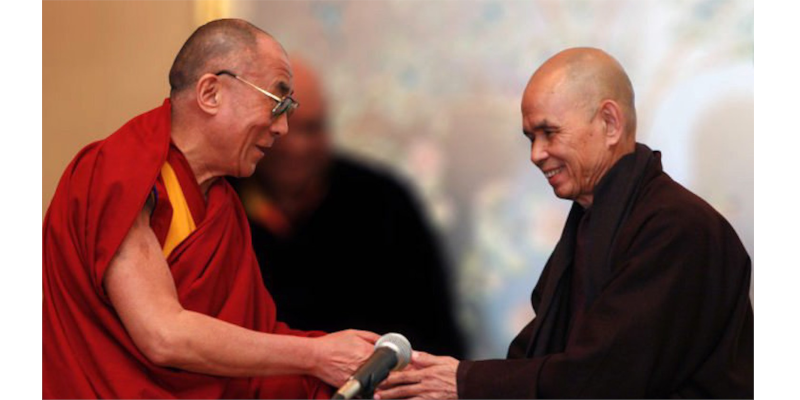Dharamshala, 24th January: Thich Nhat Hanh, a well-known Vietnamese Buddhist monk, peace activist, and outspoken opponent of the Vietnam War has died at Hue’s Tu Hieu Temple. He died at the age of 95. Plum Village, the monastic community he established, reported the news on its website. Thich Nhat Hanh died “peacefully” on Saturday morning local time, according to Plum Village.
The Plum Village statement said “Thay [Thich Nhat Hanh] has been the most extraordinary teacher, whose peace, tender compassion, and bright wisdom has touched the lives of millions, Whether we have encountered him on retreats, at public talks, or through his books and online teachings — or simply through the story of his incredible life — we can see that Thay [Thich Nhat Hanh] has been a true bodhisattva, an immense force for peace and healing in the world,”
His Holiness the Dalai Lama was saddened to learn of the death of his spiritual brother and friend, Venerable Thich Nhat Hanh. He expressed his condolences to his Vietnamese and international followers.
According to TibetToday, His Holiness wrote in his condolence message:
“In his peaceful opposition to the Vietnam war, his support for Martin Luther King and most of all his dedication to sharing with others not only how mindfulness and compassion contribute to inner peace, but also how individuals cultivating peace of mind contributes to genuine world peace, the Venerable lived a truly meaningful life. I have no doubt the best way we can pay tribute to him is to continue his work to promote peace in the world.”
H.H. Karmapa also wrote a condolence message according to TibetToday, stating “On hearing the news that the Venerable Thich Nhat Hanh has passed away, I am reminded how he was a great master who benefited many sentient beings. I would like to express my sorrow at his passing.”
He was born in central Vietnam in 1926 and became a novice monk at Tu Hieu Temple in Hue city at the age of 16. Even as a young monk, he was part of the early 1950s campaign to revive Vietnamese Buddhism, according to the Plum Village website.
Thich Nhat Hanh became motivated to aid individuals in his community who were suffering when the Vietnam War broke out in the 1950s. He also continued to practice Buddhism’s contemplative life, which prompted him to start the Engaged Buddhism movement.
In 1961, Thich Nhat Hanh moved to Princeton University to teach comparative religion. He taught at Cornell and Columbia Universities later that decade, continuing to spread a message of peace and lobbying Western authorities to halt the Vietnam War, according to Plum Village.
He started the School of Youth and Social Service in Vietnam in the early 1960s, a grassroots relief organization with 10,000 volunteers that was based on Buddhist teachings of nonviolence and compassionate action.
Thich Nhat Hanh also established the Van Hanh Buddhist University in Saigon, as well as the La Boi publishing house and a well-known peace activist magazine. According to the Plum Village website, he founded the Organization of Interbeing in 1966, a new order based on ancient Buddhist Bodhisattva rules.
Thich Nhat Hanh returned to the United States and Europe in 1966 to call for an end to hostilities in Vietnam and to continue advocating for peace in the war-torn country. On this journey, he met Martin Luther King Jr., a US civil rights hero.
Thich Nhat Hanh was nominated for the Nobel Peace Prize in 1967 by Martin Luther King Jr., who described him as “an Apostle of Peace and Nonviolence.” That year, however, no Nobel Peace Prize was given out.
In 1969, the Buddhist delegation to the Paris Peace Talks was led by the respected monk, who pressed Western officials to end the Vietnam conflict. Because of Thich Nhat Hanh’s anti-war mission, both North and South Vietnam denied him permission to return to any country for decades. He had been exiled for 39 years and was finally allowed to return to his hometown in 2005.
He suffered a stroke in 2014, rendering him speechless. He spent the rest of his days in the Tu Hieu Temple, which he had first entered as a novice monk when he was a youngster.
Image Source: RFA

